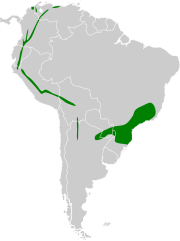| Parabuteo | |
|---|---|
 | |
| Harris's hawk (Parabuteo unicinctus) | |
| Scientific classification | |
| Domain: | Eukaryota |
| Kingdom: | Animalia |
| Phylum: | Chordata |
| Class: | Aves |
| Order: | Accipitriformes |
| Family: | Accipitridae |
| Subfamily: | Buteoninae |
| Genus: | Parabuteo Ridgway, 1874 |
| Type species | |
| Buteo harrisi [1] Audubon, 1837 | |
| Synonyms | |
AntenorRidgway, 1873 (nec Montfort, 1808) ErythrocnemaSharpe, 1874 PercnohieraxRidgway, 1920 | |
Parabuteo is a genus of bird of prey in the family Accipitridae. It contains the following species:
| Common name | Scientific name and subspecies | Range | Size and ecology | IUCN status and estimated population |
|---|---|---|---|---|
| Harris's hawk | Parabuteo unicinctus (Temminck, 1824) Two subspecies
| southern US, Mexico, Central & South America | Size: Habitat: Diet: | LC |
| White-rumped hawk | Parabuteo leucorrhous (Quoy & Gaimard, 1824) | Andes; southern Atlantic forest  | Size: Habitat: Diet: | LC |




